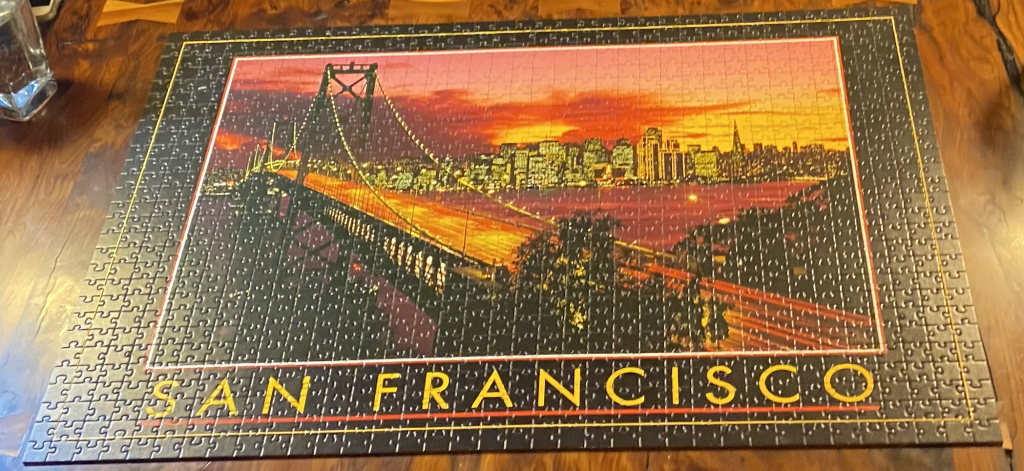One fun part about renting a vacation home for a weekend is discovering the amenities. What’s left in the spice cabinet? How many channels do they have on cable? What’s the wifi password? Many are also stocked with games. Sometimes they have a ping pong or pool tables. Usually they have board games (though only older ones like Monopoly). However, they always have jigsaw puzzles.
I love jigsaw puzzles so much that I never do them at home. Just like the Food Network, Magic the Gathering, or Diablo 2, I enjoy jigsaw puzzles so much that I have to avoid them. I am so addicted that I would do nothing else and thus must relegate it to special occasions like vacation.
In Reality is Broken, Jane McGonigal defines 4 traits to a game: a goal, rules, feedback, and voluntary participation. And jigsaw puzzles elegantly tackle all of them that you never have to be taught how to do it.
The goal: solve the dang puzzle. Get all of the pieces to fit to form the image.
The rules: pieces interlock perfectly and form an image. If they don’t fit, they aren’t supposed to go together
Feedback: every match is instant gratification
Voluntary participation: I have never been forced against my will to solve a puzzle
So I have happily solved jigsaw puzzles all my life until I encountered this monster.

Nice puzzle, right? Well, we encountered two major problems, and these related problems, one clearly visible and one less so, took six of us roughly 40 hours combined to solve.
I use what I believe is a classic strategy: start with the border, and work your way in. It’s easy to find the edge pieces, and you can get a good sense of the size and scope from there. So we did that.
Big mistake.
Look at the picture above. See that solid black border with almost no distinguishable features? We started with that. And we also ended with that.
By the end of the first evening, we had got the letters for “SAN FRANCISCO” all put in place along with a few black edges below it, and that was about it.
On the second day, we continued to work at the edges but just couldn’t make progress. Those roughly 100 edge pieces had no image to fit together, so we just had to try every piece one at a time against every other. And with only 8 possible configurations of pieces and less than millimeters of differences in size, there were a lot of pieces that looked like they fit together.
That evening, we started to work on the inside just to give ourselves a chance at finishing. Then, we discovered that the pink sky also largely lacked a color gradient. We moved 3 lamps around the coffee table to get better lighting to see those slight difference in color. Nonetheless, we kept fitting pieces in until we were left with less than 10 holes and no remaining pieces that fit.
In solving every puzzle, I believe we all come across the moment where we believe that a piece is missing. It’s the ultimate injustice: the point of a jigsaw puzzle is to find things, and you can’t find missing pieces. And experienced puzzlers know that usually pieces aren’t missing, so cue the profanity when that piece really did end up under the couch.
In this case, we did find one pink sky piece on the floor. However, the rest of the issues were tough mistakes where we had assembled sections in the wrong place. Only by re-analyzing our completed work could we fix it as we cursed the broken feedback mechanism.
Like most puzzles, we sped up towards the end as the number of remaining pieces dwindled. On that third and final day to finish the puzzle. We assembled the numerous unplaced mono-black pieces into the lid and tried them one at a time. We even carefully separated them by shape into grids so we could systematically test them out, but that system only revealed how mindless the task was.
But we could see how close we were getting, and that goal was in sight. Once we finished the inside, six pairs of hands descended upon those black edges that were both the first and last part to finish. Yet again, we had to break apart solved pieces to match them again into other areas where they fit. And yet again, we narrowed ourselves down to only 2 holes and 2 pieces that didn’t fit. And we reworked it and put in the last piece.
And it was done. We cheered, high-fived, and yelled several four-letter words. We slumped back into the couches that we had pushed in towards the coffee table for more comfortable solving and complained loudly about how unfair the puzzle was. We even left a note on the box to warn away other potential puzzlers from the horrors within like it were Jumanji.
I was relieved that we had finished, but I also felt kind of empty.
For three days, we had all shared a singular purpose to solve that puzzle. Like many games, it was otherwise pointless, and we knew it, but at least the goal was clear. It drove us for hours to hunch over and squint to interlock bits of decorated paperboard. And when it was all done, it was just done.
There’s a jigsaw puzzle sitting my board game shelf at home. Rather than the 1000 piece monster from before, this 500 piece puzzle has a nice image of Star Wars characters that should be easy to sort through. I look at it occasionally and wonder whether it would be fun to give it a shot. It probably would be fun, but then, it would be done.